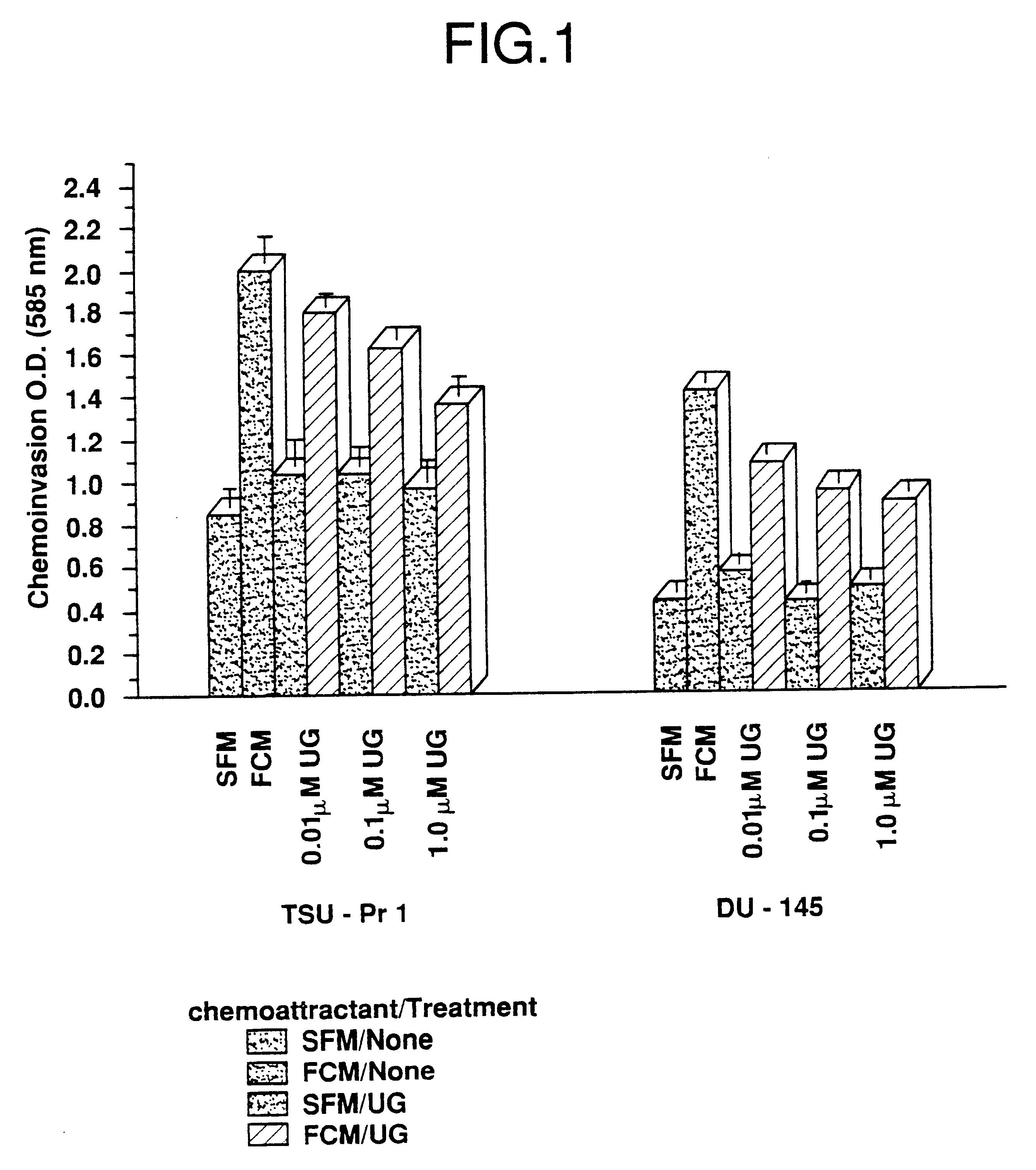Pharmaceutical compositions, methods, and kits for treatment and diagnosis of lung cancer
a technology of compositions and pharmaceutical compositions, applied in the field of pharmaceutical compositions, methods and kits, can solve the problems of life-threatening, cancer morbidity and mortality, and none of these markers can provide information concerning the time of tumor cell or cell,
- Summary
- Abstract
- Description
- Claims
- Application Information
AI Technical Summary
Problems solved by technology
Method used
Image
Examples
example 2
Cells for Assays of Metastatic Potential
The cell lines used in the illustrative embodiments herein discussed are well known and readily available. The four cell lines of the present examples all were derived from human lung cancer and are of epithelial cell origin. TSU-Pr1, DU-145 and PC3-M are androgen-independent. LNCaP is androgen-sensitive.
DU-145 is described in Stone et al., Int. J. Cancer 21: 274-281 (1978), which is incorporated herein by reference in its entirety. The cell line is available from a variety of sources including, for instance, the American Type Culture Collection (Rockville, Md.).
LNCaP is described in Horoszewicz et al., Cancer Res. 43: 1809-1818 (1983), which is herein incorporated by reference in its entirety. This cell line may be obtained from, for instance, the American Type Culture Collection (Rockville, Md.).
PC3-M is described in Kaighn et al., Invent. Urol. 11:16-23 (1976) which is herein incorporated by reference in its entirety.
TSU-Pr1 is described in...
example 3
General Assay for Invasiveness of Cells
1. Culture
As described briefly below, invasiveness of cells was assayed by the methods described in Albini et al., Cancer Research 47: 3239-3245 (1987), which is incorporated herein by reference in its entirety. Invasiveness assays and other methods for assessing anti-metastatic affects, as discussed herein below are described in Leyton et al., Cancer Research 54:3696-3699 (1994) which is incorporated by reference herein in its entirety.
Cells in logarithmic phase were detached from the growth surface by brief exposure to 0.25% trypsin, 0.25% EDTA, collected and centrifuged at 800 X g for 5 min. The pellet was resuspended in SF medium, counted and seeded into 6 mm dishes, 1.5.times.10.sup.6 cells per dish. The cells then were incubated for 24 hr in media containing zero, 0.01, 0.1 and 1.0 .mu.M uteroglobin. After the incubation cells were gently collected using a rubber policeman and assayed for invasiveness.
Fibroblast conditioned media (FCM) se...
example 4
Correlation of Optical Density with Cell Counts, and Assay of Basal Invasiveness
To calibrate optical density of the crystal violet extracts against the number of migrating cells on filters, cells were counted, seeded at known densities on filters, incubated to allow attachment and washed. One set of a duplicate set of plates was used for cell counting. The other set was used for staining. For counting, cells were released from the filters by mild trypsinization and then counted using an automated cell counter. For staining, after washing, the cells were stained and crystal violet stain then was extracted from the stained cells, as described in EXAMPLE 3. The optical densities of the extracts were measured by standard spectroscopy. The optical density determined for each filter extract was matched with the number of cells attached to its companion filter, as determined by direct counting. These paired data points served to correlate optical density with cell counts. plotted that disp...
PUM
| Property | Measurement | Unit |
|---|---|---|
| pH | aaaaa | aaaaa |
| physical | aaaaa | aaaaa |
| interstitial | aaaaa | aaaaa |
Abstract
Description
Claims
Application Information
 Login to View More
Login to View More - R&D
- Intellectual Property
- Life Sciences
- Materials
- Tech Scout
- Unparalleled Data Quality
- Higher Quality Content
- 60% Fewer Hallucinations
Browse by: Latest US Patents, China's latest patents, Technical Efficacy Thesaurus, Application Domain, Technology Topic, Popular Technical Reports.
© 2025 PatSnap. All rights reserved.Legal|Privacy policy|Modern Slavery Act Transparency Statement|Sitemap|About US| Contact US: help@patsnap.com



